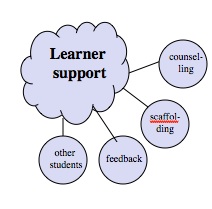The story so far
Chapter 5 of my open textbook, ‘Teaching in a Digital Age’ is about the design of teaching and learning, which I am currently writing and publishing as I go.
I started Chapter 5 by suggesting that instructors should think about design through the lens of constructing a comprehensive learning environment in which teaching and learning will take place. I have started to work through the various components of a learning environment, focusing particularly on how the digital age affects the way we need to look at some of these components.
I started by looking at how the characteristics of our learners are changing, and followed that by examining how our perspectives on content are being influenced by the digital age. In my last post, I look at how both intellectual and practical skills can be developed to meet the needs of a digital age. In this post, I discuss the importance of learner support within the learning environment. In subsequent posts, I will cover resources and assessment respectively.
This will then lead to a discussion of different models for designing teaching and learning. These models aim to provide a structure for and integration of these various components of a learning environment.
Learner support
Learner support is another critical component of an effective learning environment. It focuses on what the teacher or instructor can or should do to help learners beyond the formal delivery of content, or skills development.
Learner support covers a wide range of functions, and is a topic that will be dealt with in more depth elsewhere. Here my focus is on indicating why it is an essential component of an effective learning environment, and to describe briefly some of the main activities associated with learner support.
Scaffolding
I use the term scaffolding to cover the many functions of an instructor in diagnosing learners’ difficulties, helping students when they struggle with new concepts or ideas, helping students to gain deep understanding of a topic or subject, helping students to evaluate a range of different ideas or practices, helping students to understand the limits of knowledge, and above all challenging students to go beyond their current level of thinking or practice to acquire deeper understanding or a higher level of competency.
These activities normally take the form of personal interventions and communication between an instructor and an individual or a group of students, in face-to-face contexts or online. They tend not to be pre-planned. They are usually a means of individualising the learning, enabling student differences in learning to be better accommodated as they occur.
Feedback
This could be seen as a sub-category of scaffolding, but it covers the role of providing feedback on student performance of activities such as writing assignments, project work, creative activities, and other student activities that are beyond the current and perhaps future scope of automated computer feedback. Again, the instructor’s role here is to provide more individualisation of feedback to deal with more qualitatively assessed student activities, and may or may not be associated with formal assessment or grading.
Counselling
As well as direct support within their academic studying, learners often need help and guidance on administrative or personal issues, such as whether to repeat a course, delay an assignment because of sickness in the family, or cancel enrollment in a course and postpone it to another date. This potential source of help needs to be included in the design of an effective learning environment, with the aim of doing all that can be done to ensure that students succeed while meeting the academic standards of a program.
Other students
Other students can be a great support for learners. Much of this will happen informally, through students talking after class, through social media, or helping each other with assignments. However, instructors can make more formal use of other students by designing collaborative learning activities, group work, and designing online discussions so that students need to work together rather than individually.
Why learner support is so important
We shall see in Chapter 6 that good design can reduce substantially demand for learner support, by ensuring clarity and building in appropriate learning activities. Students also vary enormously in their need for support in learning. Many lifelong learners, who have already been through a post-secondary education, have families, careers and a great deal of life experience, can be self-managed, autonomous learners, identifying what they need to learn and how best to do this. At the other extreme, there are students for whom the formal school system was a disaster, who lack basic learning skills or foundations, such as reading, writing and mathematical skills, and therefore lack confidence in learning. These will need a lot of support to succeed.
However the vast majority of learners are somewhere in the middle of the spectrum, occasionally, no matter how good the course design, running into problems, unsure what standards are expected, and needing to know how they are doing. Indeed, there is a good deal of research that indicates that ‘instructor presence’ is associated with student success or failure in a course, at least in online learning (Anderson et al, 2001; Richardson and Swan, 2003; Garrison and Cleveland-Innes, 2005; Baker, 2010; Sheridan and Kelly, 2010). Where students feel the instructor is not present, both learner performance and completion rates decline. For such students, good, timely learner support is the difference between success and failure.
It should be noted that the need for good learner support, and the ability to provide it, is not dependent on the medium of instruction. The kind of credit online courses that have been designed and delivered long before MOOCs came along often provided high levels of learner support, through having a strong instructor presence and careful design to ensure students were supported. At the same time, although computer programs can go some way to providing learner support, many of the most important functions of learner support associated with high-level conceptual learning and skills development still need to be provided by an expert teacher or instructor, whether present or at a distance. Furthermore, this kind of learner support is difficult to scale up, as it tends to be relatively labour intensive and requires instructors with a deep level of knowledge within the subject area to provide the high-level support often needed. Thus, the need to provide adequate levels of learner support cannot just be wished away, if we are to achieve successful learning on a large scale..
This may seem obvious to teachers, but the importance of learner support for student success is not always recognised or appreciated, as can be seen from the design of many MOOCs, and the reaction of politicians and the media to the cost savings promised by MOOCs, which are entirely a function of eliminating learner support. There are also different attitudes from instructors and institutions towards the need for learner support. Some faculty may believe that ‘It’s my job to instruct and yours to learn’; in other words, once students are presented with the necessary content through lectures or reading, the rest is up to them.
Nevertheless, the reality is that in any system with a wide diversity of students, as is so common today, teachers and instructors will have to deal with students with a wide range of needs in terms of learner support, unless we are willing to sacrifice the future of many thousands of learners. This means thinking about and planning how the support can best be provided, within the constraints of the resources available, which leads us to our next topic.
Over to you
Your views, comments and criticisms are always welcome. In particular:
- do you think it is possible to design an effective course or program without the need for high levels of learner support? If so, what would it look like? A development of MOOCs or something completely different?
- do you share my views about the limitations of computers for providing the kind of high-level learner support needed for conceptual learning in a digital age? What do they do well in terms of supporting learners?
- is ‘scaffolding’ the best term to describe the kind of learning support I described in that section? If not is there a better term for this?
Or any other comments on learner support as a critical component of a learning environment, please!
Next up
How resources (or lack of them) can shape a learning environment.
References
Anderson, T., Rourke, L., Garrison, R., & Archer, W. (2001). Assessing teaching presence in a computer conferencing context. Journal of Asynchronous Learning Networks, Vol. 5, No.2.
Baker, C. (2010) The Impact of Instructor Immediacy and Presence for Online Student Affective Learning, Cognition, and Motivation The Journal of Educators Online Vol. 7, No. 1
Garrison, D. R. & Cleveland-Innes, M. (2005). Facilitating cognitive presence in online learning: Interaction is not enough. American Journal of Distance Education, Vol. 19, No. 3
Richardson, J. C., & Swan, K. (2003). Examining social presence in online courses in relation to students’ perceived learning and satisfaction. Journal of Asynchronous Learning Networks, 7 (1), 68-8 8.
Sheridan, K. and Kelly, M. (2010) The Indicators of Instructor Presence that are Important to Students in Online Courses MERLOT Journal of Online Learning and Teaching, Vol. 6, No. 4











 Dr. Tony Bates is the author of eleven books in the field of online learning and distance education. He has provided consulting services specializing in training in the planning and management of online learning and distance education, working with over 40 organizations in 25 countries. Tony is a Research Associate with Contact North | Contact Nord, Ontario’s Distance Education & Training Network.
Dr. Tony Bates is the author of eleven books in the field of online learning and distance education. He has provided consulting services specializing in training in the planning and management of online learning and distance education, working with over 40 organizations in 25 countries. Tony is a Research Associate with Contact North | Contact Nord, Ontario’s Distance Education & Training Network.


Thank you for the information about learner support in education.I am one of those learners whom their foundation or background in formal school was a disaster some of the things i know i taught myself i lack confidence and the in every thing that i do i cannot speak English properly some words i cannot even pronounce them. now that i’m university life is so difficult for me, with no knowledge of technology.
So i think yes Learner support is very important in schools.by the way i chose learner support as my Core Module to help those who were less fortunate like me, but still i will like to get more help more clarity on this course.
Thank you.
Thanks for great insights into learner support,it is true its a new chapter that seems to have been explored but unfortunately nothing much has been deeply researched and documented about it.
I would love to get more information on regard to setting up a better or somewhat system tha can support students learning taking into account of all the experiences they have gone through and how that can harnessed for their growth.
This is a very good article.
I find Learner support services extremely important if desirable learning outcomes are to be achieved.
Scaffolding in my view may represent a number of measures employed by tutors to assist learners in their effort to acquire knowledge. It may represent Learner support tuition, revision tuition, issuance of assignments (group discussions), etc in case of open, distance and electronic learning programs among many others
Computers and mobile gadgets have revolutionized digital learning experiences. A number of universities have invested heavily in robust Learner Management Systems, LMS in their effort to better manage and monitor progress of learners. Although the initial investment is high, it is cheaper in the long-term.